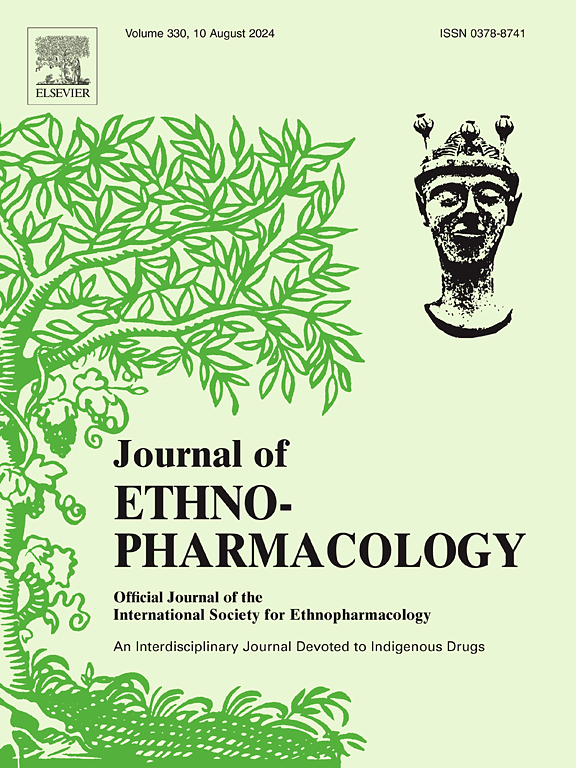Esculetin inhibited fever, pain, and inflammatory responses via binding to HSC70
IF 4.8
2区 医学
Q1 CHEMISTRY, MEDICINAL
引用次数: 0
Abstract
Ethnopharmacological relevance
Viola tianshanica Maxim, a member of the Violaceae plant family, has been traditionally used in Uighur medicine to treat pneumonia, headaches, and other ailments. A preliminary study demonstrated its antipyretic activity; however, the active components responsible for this effect have not yet been elucidated.
Aim of the study
In light of the traditional use of Viola tianshanica Maxim as an anti-inflammatory and analgesic agent in Uighur medicine, this study aims to investigate the effects of esculetin, an ethanol-extracted active compound from Viola tianshanica, on inflammation induced by lipopolysaccharide (LPS) and to explore its underlying mechanisms of action. The study seeks to elucidate the molecular pathways through which esculetin exerts its therapeutic effects and to provide scientific evidence supporting its traditional medicinal applications.
Materials and methods
The antipyretic effect was evaluated using a yeast-induced hyperthermia model. The antinociceptive effect was assessed using the acetic acid-induced writhing test and the egg white-induced paw edema method. The chemical biology method was used to design and synthesize the alkynyl-esculetin molecular probe, and the potential target protein was identified through network pharmacology analysis, magnetic trapping technology, Western blotting (WB) analysis, cellular thermal shift assay (CETSA), and surface plasmon resonance (SPR).
Results
We observed that esculetin could inhibit fever, pain, and inflammatory responses, suppress LPS-induced cyclooxygenase-2 (COX-2) and prostaglandin E2 (PGE2) expression, and reduce the levels of related pro-inflammatory factors, such as interleukin (IL-1β), IL-12, and tumor necrosis factor-alpha. Network pharmacology analysis indicated that the MAPK pathway may play a key role. Meanwhile, gene ontology analysis revealed that heat shock protein binding is involved in this process. Target fishing, CETSA, SPR, and WB assays demonstrated that esculetin targeted heat shock cognate 70 (HSC70) and reduced its protein stability. Additionally, esculetin downregulated the phosphorylation of extracellular signal-regulated kinase, protein kinase B (Akt), p38 mitogen-activated protein kinase (p38/MAPK), and AMP-activated protein kinase (AMPK). Molecular docking indicated that hydrophobic interactions and hydrogen bonding are the primary binding forces. Subsequently, HSC70 knockdown abolished the anti-inflammatory effects of esculetin.
Conclusion
The present study indicates that esculetin exhibited antipyretic, analgesic, and anti-inflammatory effects through binding with HSC70 and downregulated the p38/MAPK pathway. This study provides a new perspective for developing antipyretic, analgesic, and anti-inflammatory drugs.
Esculetin通过与HSC70结合抑制发热、疼痛和炎症反应
天山堇菜(viola tianshanica Maxim)是堇菜科植物家族的一员,在维吾尔族医学中传统上用于治疗肺炎、头痛和其他疾病。初步研究证实其有解热作用;然而,产生这种效果的有效成分尚未被阐明。摘要针对天山堇菜在维吾尔医学中的抗炎镇痛作用,本研究旨在研究天山堇菜乙醇提取的活性化合物乙酰皮素对脂多糖(LPS)诱导的炎症反应的影响,并探讨其作用机制。本研究旨在阐明槲皮素发挥其治疗作用的分子途径,并为其传统医学应用提供科学证据。材料与方法采用酵母致热模型评价其解热作用。采用醋酸扭体法和蛋清致足跖水肿法评价其抗伤性。采用化学生物学方法设计合成烷基-esculetin分子探针,并通过网络药理学分析、磁捕获技术、Western blotting (WB)分析、细胞热移测定(CETSA)、表面等离子体共振(SPR)等方法对潜在靶蛋白进行鉴定。结果槲皮素能抑制发热、疼痛和炎症反应,抑制lps诱导的环氧化酶-2 (COX-2)和前列腺素E2 (PGE2)的表达,降低相关促炎因子如白细胞介素(IL-1β)、IL-12和肿瘤坏死因子α的水平。网络药理学分析表明,MAPK通路可能起关键作用。同时,通过基因本体分析发现热休克蛋白结合参与了这一过程。靶钓鱼、CETSA、SPR和WB实验表明,esculletin靶向热休克同源蛋白70 (HSC70)并降低其蛋白稳定性。此外,esculetin下调细胞外信号调节激酶、蛋白激酶B (Akt)、p38丝裂原活化蛋白激酶(p38/MAPK)和amp活化蛋白激酶(AMPK)的磷酸化。分子对接表明疏水相互作用和氢键是主要的结合力。随后,HSC70敲低消除了esculetin的抗炎作用。结论esculetin通过与HSC70结合,下调p38/MAPK通路,发挥解热、镇痛、抗炎作用。本研究为解热、镇痛、抗炎药物的开发提供了新的思路。
本文章由计算机程序翻译,如有差异,请以英文原文为准。
求助全文
约1分钟内获得全文
求助全文
来源期刊

Journal of ethnopharmacology
医学-全科医学与补充医学
CiteScore
10.30
自引率
5.60%
发文量
967
审稿时长
77 days
期刊介绍:
The Journal of Ethnopharmacology is dedicated to the exchange of information and understandings about people''s use of plants, fungi, animals, microorganisms and minerals and their biological and pharmacological effects based on the principles established through international conventions. Early people confronted with illness and disease, discovered a wealth of useful therapeutic agents in the plant and animal kingdoms. The empirical knowledge of these medicinal substances and their toxic potential was passed on by oral tradition and sometimes recorded in herbals and other texts on materia medica. Many valuable drugs of today (e.g., atropine, ephedrine, tubocurarine, digoxin, reserpine) came into use through the study of indigenous remedies. Chemists continue to use plant-derived drugs (e.g., morphine, taxol, physostigmine, quinidine, emetine) as prototypes in their attempts to develop more effective and less toxic medicinals.
 求助内容:
求助内容: 应助结果提醒方式:
应助结果提醒方式:


